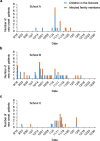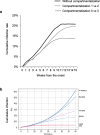Efficacy of compartmentalization in controlling an adenovirus type 54 keratoconjunctivitis outbreak on Oki Island, Japan
- PMID: 33634367
- PMCID: PMC7906084
- DOI: 10.1007/s10384-021-00826-8
Efficacy of compartmentalization in controlling an adenovirus type 54 keratoconjunctivitis outbreak on Oki Island, Japan
Abstract
Purpose: To analyze the epidemiologic characteristics of an outbreak of human adenovirus type 54 (HAdV-54) on Oki Island, Shimane Prefecture, Japan, in 2017 and to assess the effectiveness of a compartmentalization method in controlling the incidence and spread.
Study design: Retrospective cohort study.
Methods: The infection was diagnosed in 136 individuals, and typing was confirmed by PCR and direct sequencing. The epidemiologic characteristics of the disease including the infection rate, incubation period, and basic reproductive number (R0), ie, number of cases directly infected by an infectious patient during the course of the disease, were investigated. The effectiveness of compartmentalization for infection control was determined by simulating the outbreak using the Susceptible-Exposed-Infectious-Recovered (SEIR) model.
Results: The majority of the HAdV-54-infected individuals were the children of 3 nursery schools (A, B, and C) and their parents on Oki Island. The infection rates in the 3 schools were 13.2%, 16.9%, and 17.2%, respectively. The one class of school B without the index case was initially compartmentalized, and the infection rate in this compartment was 0%. The incubation period was calculated to be 9.3 ± 3.5 days, and the disease duration, 13.0 ± 5.4 days. The R0 was 1.43. Using these parameters, a SEIR model was constructed. The SEIR model well predicted the daily incidence of infection and indicated that the compartmentalization method provides effective reduction in the incidence of the infection, with much earlier control.
Conclusions: The compartmentalization method is effective to control HAdV-54 outbreaks.
Keywords: Adenovirus type 54; Basic reproductive number; Compartmentalization; Epidemic keratoconjunctivitis; Susceptible-exposed-infectious-recovered model.
Conflict of interest statement
Y. Omatsu, None; D. Miyazaki, Lecture fee (Santen, Senju, Alcon); Y. Shimizu, None; K. Matsuura, None; S. Sasaki, None; Y. Inoue, Grant (Santen, Senju, Alcon); E. Uchio, None; T. Fujimoto, None.
Figures





Similar articles
-
An outbreak of epidemic keratoconjunctivitis caused by human adenovirus type 8 in primary school, southwest China.BMC Infect Dis. 2019 Jul 15;19(1):624. doi: 10.1186/s12879-019-4232-8. BMC Infect Dis. 2019. PMID: 31307413 Free PMC article.
-
Epidemic kerato-conjunctivitis--do outbreaks have to be epidemic?Eye (Lond). 2003 Apr;17(3):356-63. doi: 10.1038/sj.eye.6700330. Eye (Lond). 2003. PMID: 12724699
-
A large outbreak of epidemic keratoconjunctivitis: problems in controlling nosocomial spread.J Infect Dis. 1989 Dec;160(6):938-43. doi: 10.1093/infdis/160.6.938. J Infect Dis. 1989. PMID: 2555421
-
Epidemiology of epidemic keratoconjunctivitis.Epidemiol Rev. 1987;9:244-61. doi: 10.1093/oxfordjournals.epirev.a036304. Epidemiol Rev. 1987. PMID: 2824228 Review. No abstract available.
-
Challenges in management of epidemic keratoconjunctivitis with emerging recombinant human adenoviruses.J Clin Virol. 2019 Mar;112:1-9. doi: 10.1016/j.jcv.2019.01.004. Epub 2019 Jan 11. J Clin Virol. 2019. PMID: 30654207 Review.
Cited by
-
Clinical insights and real-time PCR analysis of the first adeno-enterovirus conjunctivitis outbreak in India: A comprehensive cross-sectional study.J Postgrad Med. 2024 Jul 1;70(3):143-148. doi: 10.4103/jpgm.jpgm_256_24. Epub 2024 Aug 7. J Postgrad Med. 2024. PMID: 39108093 Free PMC article.
-
Viral Conjunctivitis.Viruses. 2023 Mar 4;15(3):676. doi: 10.3390/v15030676. Viruses. 2023. PMID: 36992385 Free PMC article. Review.
-
Clinical Features and Epidemiological Insights of Acute Epidemic Conjunctivitis: A Multicentric Cross-Sectional Study in North Central India.Rom J Ophthalmol. 2024 Oct-Dec;68(4):372-378. doi: 10.22336/rjo.2024.68. Rom J Ophthalmol. 2024. PMID: 39936060 Free PMC article.
References
-
- Hara J, Okamoto S, Minekawa Y, Yamazaki K, Kase T. Survival and disinfection of adenovirus type 19 and enterovirus 70 in ophthalmic practice. Jpn J Ophthalmol. 1990;34:421–427. - PubMed
MeSH terms
LinkOut - more resources
Full Text Sources
Other Literature Sources

